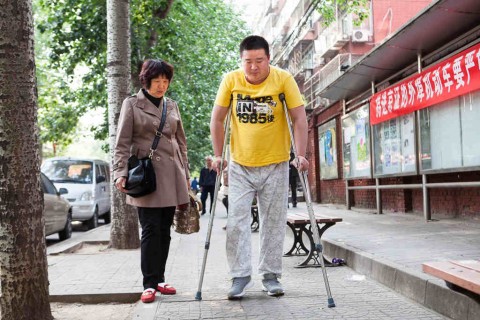Movement and coordination problems
MS can cause problems with movement, balance and coordination
Last updated: 27th October 2021
MS can cause problems with movement, balance and coordination, including:
- loss of balance
- tremor
- unstable walking (ataxia)
- giddiness (vertigo)
- clumsiness of a limb
- lack of coordination
- muscle weakness
- tightness, stiffness or ‘pull’ of muscles (spasticity)
- involuntary muscle spasms
These problems are often responsible for the physical disability that can accumulate in MS over time.
It is thought that movement problems are caused by myelin damage in the cerebellum and its connections, which impairs the workings of the network, causing uncoordinated movements. A loss of balance and vertigo has been found to be due to lesions in the complex pathways that coordinate visual, spatial and other input to the brain needed to produce and maintain body equilibrium.
Can these symptoms be treated or managed?
These symptoms can often be alleviated through physical therapy, and in many cases, initial interventions such as stretching, exercise and rehabilitation are helpful.
A number of medications have been used to treat spasticity, including baclofen, tizanidine, diazepam and dantrolene, although these have side effects which may prevent some people tolerating them.
There are only a few drug therapies which have been shown to help ataxia or tremor, and there are some surgical options for these particular symptoms.
Poor balance and vertigo are usually treated with motion sickness medication.
Download issues of MS in focus that deal with movement and coordination problems (you will need Acrobat Reader to view these files:
- MS in focus 11 Spasticity Dutch [PDF, 1MB]
- MS in focus 11 Spasticity English [PDF, 2MB]
- MS in focus 11 Spasticity Deutsch [PDF, 2MB]
- MS in focus 11 Spasticity Español [PDF, 1MB]
- MS in focus 13 Tremor and ataxia Dutch [PDF, 1MB]
- MS in focus 13 Tremor and ataxia English [PDF, 1MB]
- MS in focus 13 Tremor and ataxia Deutsch [PDF, 725KB]
- MS in focus 13 Tremor and ataxia Español [PDF, 2MB]
Madrid, Spain, 10/2011. Heads turn at the zoo’s amphitheatre as David carries his wife, Almudena, up to her seat. On the platform below, her wheelchair is equally eye-catching among a small horde of baby strollers. Making sure their son has an active life is more important than giving any serious consideration to how strangers react to the ways they cope with living with MS. Credit: Lurdes R. Basolí. Published with kind permission of the European Multiple Sclerosis Platform.
San Quirico D'Orcia, Italy, 02/2012. Martina Vagini has balance problems; in addition to using canes, she takes the trouble to go to the side of a wide staircase to be close to the railing. In a country like Italy, disability and history create a difficult barrier: laws that encourage (or even mandate) public buildings to improve accessibility often collide with laws that protect artistic heritage. Italy ranks fifth in the world as a tourist destination: in difficult economic times, beauty for the visitor often trumps access for the locals. Credit: Carlos Spottorno. Published on this website by kind permission of the European Multiple Sclerosis Platform.
